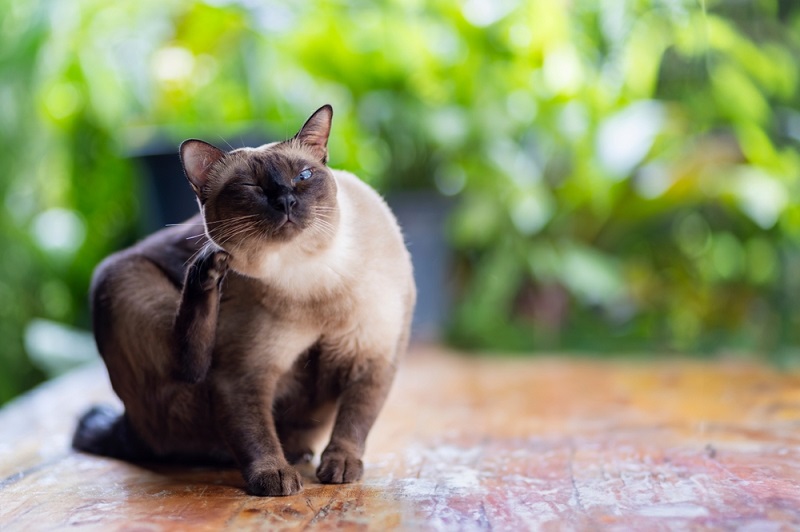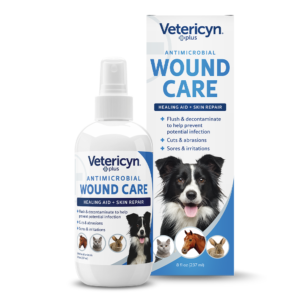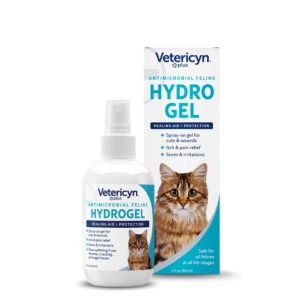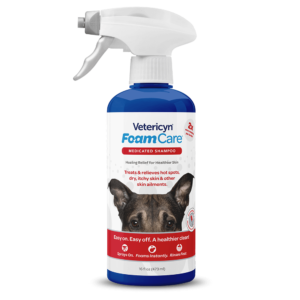Cats are famous for their meticulous grooming: They’re like tiny, self-cleaning fluff machines. But something’s off if your cat is scratching, licking, or biting themselves nonstop.
If you’re asking yourself, “Why is my cat so itchy?” you’re not alone. Itchy cats are more common than you’d think, and while the cause might be something simple like dry skin, it could also point to allergies, parasites, or even stress. In some cases, excessive scratching can lead to cat injuries, making it even more important to address the root cause quickly.
The good news? You don’t have to play “guess the itch” alone. Let’s dive into the most common causes of cat itchiness, how to spot the symptoms early, and, most importantly, what you can do to help your kitty feel comfortable, happy, and well-groomed.
What’s Making Your Cat Scratch? The Most Common Causes of Itching
Occasional grooming is normal for cats—but when it turns into a full-on scratch-a-thon, it’s a sign that your feline friend is uncomfortable. Itching often points to underlying conditions, which can vary in severity. Here are the most common culprits of itchiness:
Fleas and Other Parasites
Fleas are the number one offender when it comes to cat itching.1 Even indoor cats can pick them up from other animals or people.
Flea bites can cause irritation, and some cats are allergic to flea saliva, which makes the itching even worse.2 Other parasites, like mites or lice, can also lead to non-stop scratching and hair loss.
Allergies
Cats can develop allergies to all sorts of things: food ingredients, pollen, dust, mold, or even household cleaning products.3 If your cat’s skin is red and inflamed, or they’re itching more after meals or time spent outside, allergies might be to blame.
Dry Skin
Just like humans, cats can suffer from dry, flaky skin, especially in colder months or dry climates. This can lead to itchiness—and their constant scratching may worsen the problem or cause cat wounds.
Skin Infections
Bacterial and fungal infections, like ringworm, can make your cat’s skin itchy and irritated.4 Infections often happen after excessive scratching breaks the skin, inviting in bacteria.
Underlying Medical Conditions
Sometimes, itching is a symptom of a larger issue, like hyperthyroidism or autoimmune diseases. If your cat’s itching is persistent or paired with other symptoms like weight loss or lethargy, schedule a vet visit as soon as possible.

Is It More Than an Itch? Recognizing the Signs of a Bigger Problem
Scratching is the most obvious sign of an itchy cat—but it’s not the only one. Cats are experts at masking discomfort, so by the time they’re scratching constantly, there may be more going on beneath the surface.
Beyond scratching, keep an eye out for these signs of itchiness:
- Excessive licking, chewing, or biting – Cats groom themselves regularly, but if they’re obsessively focusing on one area or you notice damp, matted fur from over-licking, they may have some itchy skin issues.
- Hair loss or thinning fur – Pay attention to bald patches, especially around the belly, legs, or sides. This often indicates that itching has become more than a mild annoyance.
- Red, inflamed patches or sores – Irritated, raw skin can result from scratching, allergies in cats, or even infections. These areas can quickly worsen without treatment.
- Scabs or crusty spots – Scabs may form from excessive scratching or biting, and crusty areas could indicate a secondary skin infection.
- Head shaking or ear scratching – Frequent head shaking or pawing at their ears could point to ear mites, an infection, or an allergic reaction affecting their ears.
- Restlessness or irritability – If your typically chill cat suddenly seems agitated, restless, or grumpy, it might be a sign they’re struggling with persistent itching and discomfort.
If you spot any of these symptoms, especially if they’re worsening, it may be time to call your vet. The sooner you address the itching, you’ll more likely avoid painful infections, hair loss, or chronic irritation.
How to Relieve an Itchy Cat: Effective Solutions
Once you figure out what’s causing the itch, you and your vet can find the right treatment. Here’s how to soothe your cat’s skin and eliminate itch sources:
Stop Parasites in Their Tracks
If fleas, mites, or lice are the culprits, act fast. Your vet may recommend a variety of parasite treatments, including:
- Topical treatments – These are applied directly to your cat’s skin, usually at the back of the neck, where they can’t lick it off. They work by spreading through the skin’s oils, quickly killing fleas, mites, and other parasites on contact.
- Oral medications – Given as a pill or chewable treat, oral parasite medications work from the inside out. They circulate through your cat’s bloodstream, killing pests when they bite. These treatments are fast-acting and can eliminate fleas within hours while preventing future infestations long term.
- Flea collars – Modern flea collars have come a long way from older versions. Many now release a controlled dose of active ingredients that repel and kill fleas, ticks, and other pests for several months. They provide long-lasting protection without the need for frequent reapplication.
For added comfort, consider using Vetericyn Plus Antimicrobial Wound and Skin Care Spray to help soothe irritated skin and support healing from any bites or sores.
Ease Allergy Discomfort
If your cat’s itching is due to food allergies, consider switching them to a hypoallergenic or limited-ingredient diet. For environmental allergies, your vet might recommend:
- Antihistamines – Antihistamines can help reduce itching and inflammation, providing relief from environmental allergies.5
- Allergy shots (immunotherapy) – Allergy shots, also known as immunotherapy, may be recommended for more severe or chronic allergy cases to build your cat’s tolerance to allergens gradually.
- Environmental changes – Making environmental changes, such as keeping your home clean, using air purifiers, and minimizing dust, can significantly reduce your cat’s exposure to common allergens.
To soothe your cat’s irritated skin, Vetericyn Plus Antimicrobial Hydrogel can provide a protective, moisturizing barrier—perfect for calming inflamed areas.
Relieve Dry Skin
Dry skin is uncomfortable for everyone, including cats. Help your cat stay hydrated and itch-free by feeding them a skin-supporting diet. Look for foods rich in omega-3 and omega-6 fatty acids to nourish their skin from the inside out.6
Dry indoor air, especially in winter, can strip moisture from your cat’s skin. A humidifier helps keep their environment more skin-friendly.
Treat Infections Quickly
Skin infections—whether bacterial or fungal—require fast action. Your vet may prescribe:
- Medicated cat shampoo cleanses and treats the affected areas, helping to remove bacteria or fungi from your cat’s skin.
- Topical treatments designed to target localized infections or hot spots in cats, providing direct relief to irritated areas.
- Antibiotics or antifungal medications to combat more widespread or severe infections that you can’t manage with topical care alone.
Pair these treatments with pet wound spray to speed up healing, soothe irritation, and prevent infections from worsening.

How to Keep Your Cat Comfortable Year-Round
Stopping the itch before it starts is the best way to ensure your cat stays happy, healthy, and comfortable.
Prevention isn’t just about avoiding irritation—it’s about promoting overall skin and coat health. Here’s how to keep your cat itch-free all year long:
- Stay on top of flea prevention – Fleas can cause itchiness in cats no matter the season. Practice year-round, vet-recommended flea prevention, even if your cat stays indoors. Fleas can hitch a ride on your clothes or the coats of other pets, so consistent protection is key.
- Create a cat-friendly environment – Allergens like dust, mold, and pollen can trigger skin irritation in sensitive cats. Regularly clean your home, including your cat’s favorite lounging spots, bedding, and litter area. Consider using an air purifier to minimize airborne allergens and improve overall air quality.
- Keep up with grooming – Regular brushing helps prevent mats, removes loose fur, and minimizes dirt, debris, and allergens that might irritate your cat’s skin. It also gives you a chance to spot any redness, sores, or bumps early before they become larger problems. Even short-haired cats benefit from occasional grooming.
- Watch for changes – If your cat starts scratching more than usual, don’t ignore it. Early intervention can prevent a minor itch from turning into a major skin issue. Pay attention to other signs of itchiness like excessive licking, hair loss, or redness — and if you notice anything unusual, reach out to your vet for guidance.
By staying proactive with skin and coat care, you’ll help your cat avoid the itch—and stay comfortable, cozy, and carefree year-round.
Help Your Cat Ditch the Itch with Vetericyn
Whether it’s parasites, cat skin allergies, dry skin, or an infection causing the scratching frenzy, identifying the root cause of itchy skin is key to providing lasting relief. With a little detective work, you can uncover their itching triggers and take action to stop it.
And when your cat needs extra support, Vetericyn is here to help. Our gentle, vet-recommended pet skin care products provide soothing relief and promote healing for irritated skin, giving your feline friend the comfort they deserve.
With the right feline care products, your cat will be back to their curious, playful self, no scratching required. So, the next time you find yourself wondering, “Why is my cat so itchy?” you’ll not only know why, but you’ll also know exactly how to help.
 Reviewed by dr. Kathy Adamson
Reviewed by dr. Kathy Adamson
Dr. Kathy Adamson earned her bachelor’s degree from the University of Notre Dame and her Doctor of Veterinary Medicine degree from the University of Wisconsin-Madison School of Veterinary Medicine.
She completed a one-year small animal medicine and surgery internship at the North Carolina State College of Veterinary Medicine. Alongside her studies, Kathy worked in a research lab, contributing as an author and co-author to various journal articles.
She has also pursued medical writing and editing certification through the University of Chicago Graham School. Currently, she runs KMA Veterinary & Medical Writing, a freelance medical writing company, serves as the Digital Content Manager for the Greater Chicago Area Chapter of the American Medical Writers Association, is a member of the AMWA Communications Committee, and enjoys writing about healthcare topics for people and their cherished pets.
![]() https://www.linkedin.com/in/kathyadamsondvm/
https://www.linkedin.com/in/kathyadamsondvm/
Sources:
- VetHelpDirect. Top Five Causes of Itching in Cats. https://vethelpdirect.com/vetblog/2020/06/04/top-five-causes-of-itching-in-cats/
- WebMD. When Your Dog or Cat Has a Flea Allergy. https://www.webmd.com/pets/features/flea-allergies
- VCA Hospitals. Allergies in Cats. https://vcahospitals.com/know-your-pet/allergies-in-cats
- Royal Canin. Skin Problems in Cats – Bacterial and Fungal Infections. https://www.royalcanin.com/us/cats/health-and-wellbeing/skin-problems-in-cats-bacterial-and-fungal-infections
- WebMD. What to Know About Antihistamines for Cats. https://www.webmd.com/pets/cats/what-to-know-about-antihistamines-for-cats
- Healthline. The 11 Best Foods for Healthy Skin. https://www.healthline.com/nutrition/12-foods-for-healthy-skin


